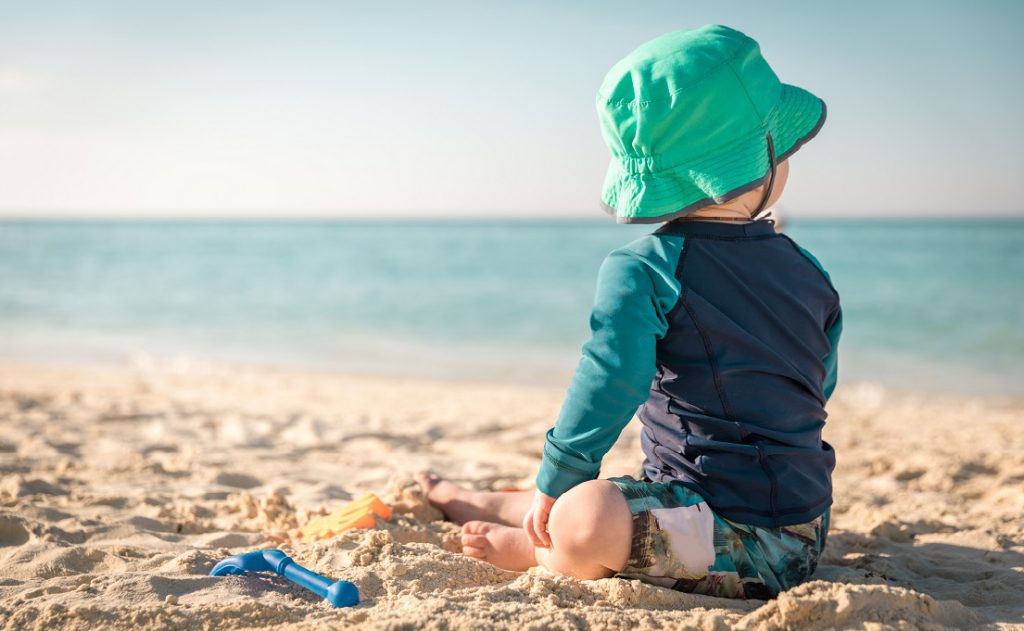Keeping infants and toddlers safe is an exhausting full-time job, and every parent knows just how important it is to get it right. You’ve childproofed your home, purchased the safest stroller and stocked up on healthy baby food — but have you thought about sun protection? Protecting young children from harmful ultraviolet (UV) radiation is important not only for avoiding immediate consequences like painful sunburns, but also for minimizing skin cancer risk later in life. Here’s what you need to know about keeping the baby in your life sun safe.
Tiny Babies, Big Risk
In their first few months, babies are much more sensitive to sun exposure than adults and older children. Their skin contains little melanin, the pigment that gives color to skin, hair and eyes and provides some sun protection. You may be tempted to reach for the sunscreen, but The Skin Cancer Foundation recommends waiting until the baby is 6 months old before introducing sunscreen. The best ways to keep infants sun safe are with shade and clothing.
Clothing is the first line of defense against skin cancer, and dressing babies in lightweight clothing that covers their arms and legs is a great first sun protection step. Then add on a wide-brimmed hat that covers the baby’s face, neck and ears — putting a child in a hat during their first few months will help them get used to having one on. (Bonus: they’ll look super cute!) When you’re on the move, use a stroller with a sun-protective cover and do your best to schedule walks before 10 AM and after 4 PM, avoiding strong midday sun. While traveling in the car, try a removable mesh window shield to block sunlight from reaching your little one. Yes, some damaging rays penetrate glass.
No matter what, never allow a baby to get a sunburn. In infants, sunburns can be a medical emergency, with the potential to cause fever, dehydration, blisters and chills.
Time for Sunscreen
Once your baby is 6 months old, it’s time to introduce sunscreen. This doesn’t mean it’s OK to forget all the other sun protection methods you’ve been using with your baby — covering up with clothing and seeking shade are still important. But as your baby gets older and you spend more time outdoors, sunscreen will help protect exposed skin, like the hands and face. Choose a broad-spectrum sunscreen (meaning it protects against UVA and UVB rays) with an SPF of 30 or higher. Look for sunscreens with zinc oxide and titanium oxide. These ingredients don’t need to be absorbed into the skin to work, so they’re less likely to cause a reaction on sensitive skin. Just in case, though, it’s best to test a new sunscreen before applying thoroughly. Apply a little sunscreen on the inside of your baby’s wrist and watch for signs of irritation, which may take as long as several days to develop.
Once children begin crawling and walking, they can be difficult to catch, let alone held onto long enough to apply sunscreen. Getting a little creative with the formulation of the sunscreen you use can help, so try out lotions, sticks and sprays to see what works for your child. Stick sunscreens earn points because toddlers are less likely to rub the product in their eyes, and sprays can be convenient for quick application — just be sure to apply in a ventilated space, and don’t spray the product directly onto a child’s face.
Healthy Lifetime Habits
Though preventing painful sunburns is the most immediate benefit of keeping kids sun safe, instilling habits like sunscreen application and wearing hats will have benefits that long outlast a child’s early years. When kids grow up practicing a sun protection routine, they’ll be more likely to continue those behaviors into adulthood, lowering their risk of every type of skin cancer and premature skin aging. So next time you consider your infant’s health needs, don’t forget about a sun protection plan!




